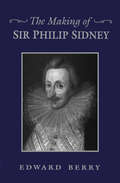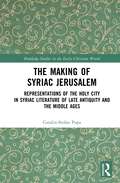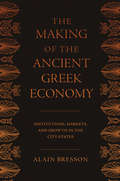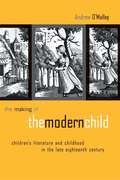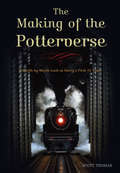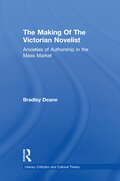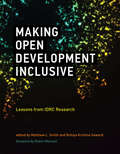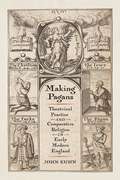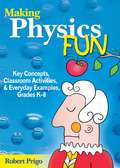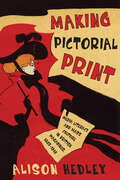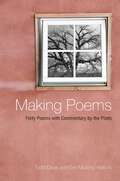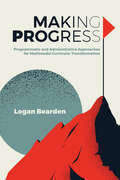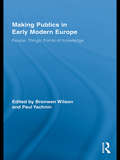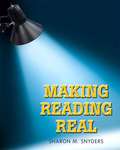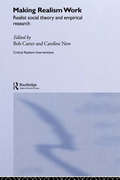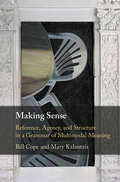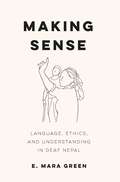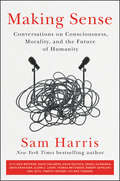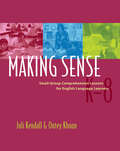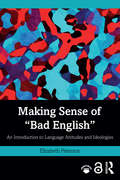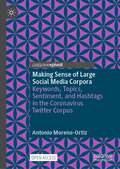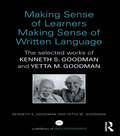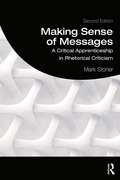- Table View
- List View
The Making of Sir Philip Sidney
by Edward DerryDoes a poet make himself, or do his culture and his fiction make him? Sir Philip Sidney is one of the most popular and enduring of Elizabethan authors, and one of those most preoccupied with the relationship between self, society, and art. Edward Berry's The Making of Sir Philip Sidney explores how Sidney 'made' or created himself as a poet by 'making' representations of himself in the roles of some of his most literary creations: Philisides, Astrophil, and the intrusive persona of the Defence of Poetry. Focusing on the significance of these and other self-representations throughout Sidney's career, Berry combines biography, social history, and literary criticism to achieve a carefully balanced portrayal of the poet's life and work. This is a book that makes a significant contribution to our understanding of Sidney, and is likely to appeal to both students and scholars of Sidney, as well as to those wishing to understand the cultural events that shaped this central figure of the English Renaissance.
The Making of Syriac Jerusalem: Representations of the Holy City in Syriac Literature of Late Antiquity and the Middle Ages (Routledge Studies in the Early Christian World)
by Catalin-Stefan PopaThis book discusses hagiographic, historiographical, hymnological, and theological sources that contributed to the formation of the sacred picture of the physical as well as metaphysical Jerusalem in the literature of two Eastern Christian denominations, East and West Syrians. Popa analyses the question of Syrian beliefs about the Holy City, their interaction with holy places, and how they travelled in the Holy Land. He also explores how they imagined and reflected the theology of this itinerary through literature in Late Antiquity and the Middle Ages, set alongside a well-defined local tradition that was at times at odds with Jerusalem. Even though the image of Jerusalem as a land of sacred spaces is unanimously accepted in the history of Christianity, there were also various competing positions and attitudes. This often promoted the attempt at mitigating and replacing Jerusalem’s sacred centrality to the Christian experience with local sacred heritage, which is also explored in this study. Popa argues that despite this rhetoric of artificial boundaries, the general picture epitomises a fluid and animated intersection of Syriac Christians with the Holy City especially in the medieval era and the subsequent period, through a standardised process of pilgrimage, well-integrated in the custom of advanced Christian life and monastic canon. The Making of Syriac Jerusalem is suitable for students and scholars working on the history, literature, and theology of Syriac Christianity in the late antique and medieval periods.
The Making of the Ancient Greek Economy
by Alain Bresson Steven RendallThis comprehensive introduction to the ancient Greek economy revolutionizes our understanding of the subject and its possibilities. Alain Bresson is one of the world's leading authorities in the field, and he is helping to redefine it. Here he combines a thorough knowledge of ancient sources with innovative new approaches grounded in recent economic historiography to provide a detailed picture of the Greek economy between the last century of the Archaic Age and the closing of the Hellenistic period. Focusing on the city-state, which he sees as the most important economic institution in the Greek world, Bresson addresses all of the city-states rather than only Athens. An expanded and updated English edition of an acclaimed work originally published in French, the book offers a groundbreaking new theoretical framework for studying the economy of ancient Greece; presents a masterful survey and analysis of the most important economic institutions, resources, and other factors; and addresses some major historiographical debates. Among the many topics covered are climate, demography, transportation, agricultural production, market institutions, money and credit, taxes, exchange, long-distance trade, and economic growth.The result is an unparalleled demonstration that, unlike just a generation ago, it is possible today to study the ancient Greek economy as an economy and not merely as a secondary aspect of social or political history. This is essential reading for students, historians of antiquity, and economic historians of all periods.
The Making of the Greek Genocide: Contested Memories of the Ottoman Greek Catastrophe (War and Genocide #23)
by Erik SjöbergDuring and after World War I, over one million Ottoman Greeks were expelled from Turkey, a watershed moment in Greek history that resulted in hundreds of thousands of deaths. And while few dispute the expulsion's tragic scope, it remains the subject of fierce controversy, as activists have fought for international recognition of an atrocity they consider comparable to the Armenian genocide. This book provides a much-needed analysis of the Greek genocide as cultural trauma. Neither taking the genocide narrative for granted nor dismissing it outright, Erik Sjöberg instead recounts how it emerged as a meaningful but contested collective memory with both nationalist and cosmopolitan dimensions.
The Making of the Modern Child: Children's Literature in the Late Eighteenth Century (Children's Literature and Culture #Vol. 28)
by Andrew O'MalleyThis book explores how the concept of childhood in the late-18th century was constructed through the ideological work performed by children's literature, as well as pedagogical writing and medical literature of the era. Andrew O'Malley ties the evolution of the idea of "the child" to the growth of the middle class, which used the figure of the child as a symbol in its various calls for social reform.
The Making of the Potterverse: A Month-by-Month Look at Harry's First 10 Years
by Scott ThomasExperience the magic again with this chronicle of the young wizard who took the world by storm! From the moment that J. K. Rowling conceived the idea of Harry Potter during a train ride, until the 1997 UK publication of Harry Potter and the Philosopher&’s Stone, The Making of the Potterverse tells the history of one of today&’s most beloved sagas—in print, on screen, and in real life as waves of Pottermania swept fans young and old. Covering the phenomenon through the theatrical release of Harry Potter and the Order of the Phoenix, this book covers all of the major and minor news events centering on the world of Harry Potter, interweaving quotes from the films&’ cast and crew members—among them Daniel Radcliffe, Emma Watson, and Rupert Grint; directors Chris Columbus (The Sorcerer&’s Stone, The Chamber of Secrets), Alfonso Cuarón (The Prisoner of Azkaban), and Mike Newell (The Goblet of Fire); producer David Heyman, and behind-the-scenes personnel who bring the magic to life.
Making of the Victorian Novelist: Anxieties of Authorship in the Mass Market (Literary Criticism and Cultural Theory)
by Bradley DeaneFirst Published in 2003. Routledge is an imprint of Taylor & Francis, an informa company.
Making Open Development Inclusive: Lessons from IDRC Research (International Development Research Centre)
by Matthew L. Smith and Ruhiya Kristine SewardDrawing on ten years of empirical work and research, analyses of how open development has played out in practice.A decade ago, a significant trend toward openness emerged in international development. "Open development" can describe initiatives as disparate as open government, open health data, open science, open education, and open innovation. The theory was that open systems related to data, science, and innovation would enable more inclusive processes of human development. This volume, drawing on ten years of empirical work and research, analyzes how open development has played out in practice.
Making Pagans: Theatrical Practice and Comparative Religion in Early Modern England (Published in cooperation with the Folger Shakespeare Library)
by John KuhnHow early modern theatrical practice helped construct the category of “pagan” as a tool of European self-definition and colonial ambitionIn Making Pagans, John Kuhn argues that drama played a powerful role in the articulation of religious difference in the seventeenth century. Tracing connections between the history of stagecraft and ethnological disciplines such as ethnography, antiquarianism, and early comparative religious writing, Kuhn shows how early modern repertory systems that leaned heavily on thrift and reuse produced an enduring theatrical vocabulary for understanding religious difference through the representation of paganism—a key term in the new taxonomy of world religions emerging at this time, and a frequent subject and motif in English drama of the era.Combining properties such as triumphal chariots, trick altars, and moving statues with music, special effects, and other elements, the spectacular set-pieces that were mostly developed for plays set in antiquity, depicting England’s pre-Christian past, were frequently repurposed in new plays, in representations of Native Americans and Africans in colonial contact zones. Kuhn argues that the recycling of these set-pieces encouraged audiences to process new cultural sites through the lens of old performance tropes, and helped produce fictitious, quasi-ethnographic knowledge for spectators, generating the idea of a homogeneous, trans-historical, trans-geographical “paganism.” Examining the common scenes of pagan ritual that filled England's seventeenth-century stages—magical conjurations, oracular prophecies, barbaric triumphal parades, and group suicides—Kuhn traces these tropes across dozens of plays, from a range of authors including Ben Jonson, Christopher Marlowe, John Dryden, and Philip Massinger.Drawing together theater history, Atlantic studies, and the history of comparative religion, Making Pagans reconceptualizes the material and iterative practices of the theater as central to the construction of radical religious difference in early modernity and of the category of paganism as a tool of European self-definition and colonial ambition.
Making Physics Fun: Key Concepts, Classroom Activities, and Everyday Examples, Grades K?8
by Robert PrigoBoost student interest and understanding in the physical sciences!Teaching physical science in the elementary and middle grades can be challenging for busy teachers faced with growing demands and limited resources. Robert Prigo provides fun and engaging activities using safe, available materials that educators can easily incorporate into lesson plans. Extensive examples, sample inquiry questions, and ideas for initiating units are readily available for teachers to pick and choose from to meet student needs.The result of more than two decades of professional development work with hundreds of teachers and administrators, this resource addresses specific areas of physical science, including motion and force, waves and sound, light and electromagnetic waves, and more. Dozens of activities demonstrating physics in action help students of all ages relate physics principles to their everyday experiences.This practitioner-friendly resource helps teachers: Address the "big ideas" in K-8 science education Promote student understanding with ready-to-use learning experiences Use hands-on activities to help students make larger, real-world connections Assemble classroom learning centers to facilitate deeper understanding of basic physics principlesWith conceptual summaries to support teachers' proficiency and understanding of the content, this guidebook is ideal for bringing physics to life for students in the classroom and in their lives!
Making Pictorial Print: Media Literacy and Mass Culture in British Magazines, 1885–1918 (Studies in Book and Print Culture)
by Alison HedleyAt the end of the nineteenth century, print media dominated British popular culture, produced in greater variety and on a larger scale than ever before. Within decades, new visual and auditory media had ushered in a mechanized milieu, displacing print from its position at the heart of cultural life. During this period of intense change, illustrated magazines maintained a central position in the media landscape by transforming their letterpress orientation into a visual and multimodal one. Ultimately, this transformation was important for the new media cultures of the twentieth and twenty-first centuries. Making Pictorial Print recovers this chapter in the history of new media, applying concepts from media theory and the digital humanities to analyse four popular late-Victorian magazines – the Illustrated London News, the Graphic, Pearson’s Magazine, and the Strand – and the scrapbook media that appropriated them. Using the concept of media literacy, these case studies demonstrate the ways in which periodical design aesthetics affected the terms of engagement presented to readers, creating opportunities for them to participate in and even contribute to popular culture. Shaped by publishers, advertisers, and readers themselves, the pages of these periodicals document the emergence of modern mass culture as we know it and offer insight into the new media of our digital present.
Making Poems: Forty Poems with Commentary by the Poets (Excelsior Editions)
by Todd Davis Erin MurphyThis diverse collection of poems and companion essays by forty nationally and internationally known poets allows readers to experience the creative process through the eyes and voice of each poet. No matter how often we are told that revision is an essential component of poetic composition, it can be difficult to resist the temptation to think of the poem as having sprung spontaneously, Athena-like, from the writer's head. By exposing readers to the finished product as well as the poet's own account of the poem's creation, Making Poems offers a behind-the-scenes perspective on the poetic process that will fascinate both beginning and established writers. The book also affords poetry instructors an opportunity to demonstrate to their students the ways in which poems can originate from seemingly mundane and unlikely sources.
Making Progress: Programmatic and Administrative Approaches for Multimodal Curricular Transformation
by Logan BeardenMaking Progress is an empirical investigation into the strategies and processes first-year composition programs can use to center multimodal work in their curricula. Logan Bearden makes a unique contribution to the field, presenting a series of flexible strategies, evolving considerations, and best practices that can be taken up, adapted, and implemented by programs and directors that want to achieve what Bearden brands “multimodal curricular transformation,” or MCT, at their own institutions. MCT can be achieved at the intersection of program documents and practices. Bearden details ten composition programs that have undergone MCT, offering interview data from the directors who oversaw and/or participated within the processes. He analyzes a corpus of outcomes statements to discover ways we can “make space” for multimodality and gives instructors and programs a broader understanding of the programmatic values for which they should strive if they wish to make space for multimodal composition in curricula. Making Progress also presents how other program documents like syllabi and program websites can bring those outcomes to life and make multimodal composing a meaningful part of first-year composition curricula. First-year composition programs that do not help their students learn to compose multimodal texts are limiting their rhetorical possibilities. The strategies in Making Progress will assist writing program directors and faculty who are interested in using multimodality to align programs with current trends in disciplinary scholarship and deal with resistance to curricular revision to ultimately help students become more effective communicators in a digital-global age.
Making Publics in Early Modern Europe: People, Things, Forms of Knowledge (Routledge Studies in Renaissance Literature and Culture)
by Bronwen Wilson Paul YachninThe book looks at how people, things, and new forms of knowledge created "publics" in early modern Europe, and how publics changed the shape of early modern society. The focus is on what the authors call "making publics" — the active creation of new forms of association that allowed people to connect with others in ways not rooted in family, rank or vocation, but rather founded in voluntary groupings built on the shared interests, tastes, commitments, and desires of individuals. By creating new forms of association, cultural producers and consumers challenged dominant ideas about just who could be a public person, greatly expanded the resources of public life for ordinary people in their own time, and developed ideas and practices that have helped create the political culture of modernity. Coming from a number of disciplines including literary and cultural studies, art history, history of religion, history of science, and musicology, the contributors develop analyses of a range of cases of early modern public-making that together demonstrate the rich inventiveness and formative social power of artistic and intellectual publication in this period.
Making Reading Real
by Sharon M. SnydersThis skills-based Reading text/series addresses a major challenge in the course -- engaging students -- by giving them diverse and relevant readings with integrated coverage of learning styles.
Making Realism Work: Realist Social Theory and Empirical Research
by Bob Carter Caroline NewIn this innovative book, theorists and researchers from various social science disciplines explore the potential of realist social theory for empirical research. The examples are drawn from a wide range of fields health and medicine, crime, housing, sociolinguistics, development theory and deal with issues such as causality, probability, and reflexivity in social science. Varied and lively contributions relate central methodological issues to detailed accounts of research projects which adopt a realist framework. Making Realism Work provides an accessible discussion of a significant current in contemporary social science and will be of interest to social theorists and social researchers alike.
Making Sense: Reference, Agency, and Structure in a Grammar of Multimodal Meaning
by Bill Cope Mary KalantzisThe phenomenon of multimodality is central to our everyday interaction. 'Hybrid' modes of communication that combine traditional uses of language with imagery, tagging, hashtags and voice-recognition tools have become the norm. Bringing together concepts of meaning and communication across a range of subject areas, including education, media studies, cultural studies, design and architecture, the authors uncover a multimodal grammar that moves away from rigid and language-centered understandings of meaning. They present the first framework for describing and analysing different forms of meaning across text, image, space, body, sound and speech. Succinct summaries of the main thinkers in the fields of language, communications and semiotics are provided alongside rich examples to illustrate the key arguments. A history of media including the genesis of digital media, Unicode, Emoji, XML and HTML, MP3 and more is covered. This book will stimulate new thinking about the nature of meaning, and life itself, and will serve practitioners and theorists alike.
Making Sense: Language, Ethics, and Understanding in Deaf Nepal
by E. Mara GreenA free ebook version of this title is available through Luminos, University of California Press's Open Access publishing program. Visit www.luminosoa.org to learn more.Making Sense explores the experiential, ethical, and intellectual stakes of living in, and thinking with, worlds wherein language cannot be taken for granted. In Nepal, many deaf signers use Nepali Sign Language (NSL), a young, conventional signed language. The majority of deaf Nepalis, however, use what NSL signers call natural sign. Natural sign involves conventional and improvisatory signs, many of which recruit semiotic relations immanent in the social and material world. These features make conversation in natural sign both possible and precarious. Sense-making in natural sign depends on signers' skillful use of resources and on addressees' willingness to engage. Natural sign reveals the labor of sense-making that in more conventional language is carried by shared grammar. Ultimately, this highly original book shows that emergent language is an ethical endeavor, challenging readers to consider what it means, and what it takes, to understand and to be understood.
Making Sense: Conversations on Consciousness, Morality, and the Future of Humanity
by Sam HarrisFrom the bestselling author of Waking Up and The End of Faith, an adaptation of his wildly popular, often controversial podcast“Civilization rests on a series of successful conversations.” —Sam Harris Sam Harris—neuroscientist, philosopher, and bestselling author—has been exploring some of the most important questions about the human mind, society, and current events on his podcast, Making Sense. With over one million downloads per episode, these discussions have clearly hit a nerve, frequently walking a tightrope where either host or guest—and sometimes both—lose their footing, but always in search of a greater understanding of the world in which we live. For Harris, honest conversation, no matter how difficult or controversial, represents the only path to moral and intellectual progress. This book includes a dozen of the best conversations from Making Sense, including talks with Daniel Kahneman, Timothy Snyder, Nick Bostrom, and Glen Loury, on topics that range from the nature of consciousness and free will, to politics and extremism, to living ethically. Together they shine a light on what it means to “make sense” in the modern world.
Making Sense: Small-Group Comprehension Lessons for English Language Learners
by Juli Kendall Outey KhuonReading is all about understanding. How do we know our kids are getting it—and what do we do when they don't get it? Authors Juli Kendall and Outey Khuon believe that small group comprehension lessons have a key role to play in advancing students' understanding of texts. Making Sense: Small-Group Comprehension Lessons for English Language Learners , they provide answers to many common questions asked by teachers of ELL. It is an easy-to-use, practical resource for ELD, ESL, and ESOL teachers.The book's five main sections are geared to the stages of language proficiency, and lessons span kindergarten through grade 8. The authors outline 52 lessons that teach students how to make connections, visualize, infer, and determine importance. Each lesson follows a four-part teaching framework: Start Up/Connection: Helping students build background and use prior knowledge to connect to the lesson Give Information : Explicitly telling students what they are going to learn and why they are learning it Active Involvement : Students practice what they are learning while the teacher monitors and adjusts instruction accordingly Off-You-Go!: Opportunities for students to practice what they learned with peers or independently. Making Sense will appeal to experienced teachers seeking to expand their repertoire of lessons, as well as new teachers just beginning the adventure of teaching comprehension to English language learners.
Making Sense: A Guide to Sound Reasoning and Critical Thinking (Eighth Edition)
by Debra StevensThis is not a book on how to win arguments. We do not need to know how to make points and appear to be right. We need to learn how to think and speak honestly, with integrity. Developing integrity in one's thinking begins with carefully observing and questioning what one believes one sees and hears.
Making Sense of "Bad English": An Introduction to Language Attitudes and Ideologies
by Elizabeth PetersonWhy is it that some ways of using English are considered "good" and others are considered "bad"? Why are certain forms of language termed elegant, eloquent or refined, whereas others are deemed uneducated, coarse, or inappropriate? Making Sense of "Bad English" is an accessible introduction to attitudes and ideologies towards the use of English in different settings around the world. Outlining how perceptions about what constitutes "good" and "bad" English have been shaped, this book shows how these principles are based on social factors rather than linguistic issues and highlights some of the real-life consequences of these perceptions. Features include: an overview of attitudes towards English and how they came about, as well as real-life consequences and benefits of using "bad" English; explicit links between different English language systems, including child’s English, English as a lingua franca, African American English, Singlish, and New Delhi English; examples taken from classic names in the field of sociolinguistics, including Labov, Trudgill, Baugh, and Lambert, as well as rising stars and more recent cutting-edge research; links to relevant social parallels, including cultural outputs such as holiday myths, to help readers engage in a new way with the notion of Standard English; supporting online material for students which features worksheets, links to audio and news files, further examples and discussion questions, and background on key issues from the book. Making Sense of "Bad English" provides an engaging and thought-provoking overview of this topic and is essential reading for any student studying sociolinguistics within a global setting.
Making Sense of Large Social Media Corpora: Keywords, Topics, Sentiment, and Hashtags in the Coronavirus Twitter Corpus
by Antonio Moreno-OrtizThis open access book offers a comprehensive overview of available techniques and approaches to explore large social media corpora, using as an illustrative case study the Coronavirus Twitter corpus. First, the author describes in detail a number of methods, strategies, and tools that can be used to access, manage, and explore large Twitter/X corpora, including both user-friendly applications and more advanced methods that involve the use of data management skills and custom programming scripts. He goes on to show how these tools and methods are applied to explore one of the largest Twitter datasets on the COVID-19 pandemic publicly released, covering the two years when the pandemic had the strongest impact on society. Specifically, keyword extraction, topic modelling, sentiment analysis, and hashtag analysis methods are described, contrasted, and applied to extract information from the Coronavirus Twitter Corpus. The book will be of interest to students and researchers in fields that make use of big data to address societal and linguistic concerns, including corpus linguistics, sociology, psychology, and economics.
Making Sense of Learners Making Sense of Written Language: The Selected Works of Kenneth S. Goodman and Yetta M. Goodman
by Kenneth S. Goodman Yetta M. GoodmanKen and Yetta Goodman’s professional work has been a lifelong collaboration, informed by shared philosophical strands. An overarching goal has been to provide access for all children to literacy and learning and to inform and improve teaching and learning. Each also is recognized for specific areas of focus and is known for particular concepts. This volume brings together a thoughtfully crafted selection of their key writings, organized around five central themes: research and theory on the reading process and written language development; teaching; curriculum and evaluation; the role of language; advocacy and the political nature of schooling. In the World Library of Educationalists, international scholars themselves compile career-long collections of what they judge to be their finest pieces – extracts from books, key articles, salient research findings, major theoretical and/practical contributions – so the world can read them in a single manageable volume. Readers will be able to follow the themes and strands of their work and see their contribution to the development of a field, as well as the development of the field itself.
Making Sense of Messages: A Critical Apprenticeship in Rhetorical Criticism
by Mark StonerMaking Sense of Messages, now in its second edition, retains the apprenticeship approach which facilitates effectively learning the complex content and skills of rhetorical theory and criticism. A new chapter on “The Rhetoric of Ignorance” provides needed theory and examples that help students deal with the new rhetorical landscape marked by such discursive complexities as “fake news,” “whataboutism,” and denial of science that creates rather than reduces uncertainty in public argument. A new chapter, “Curating and Analyzing Multimodal Mediated Rhetoric,” deals with problems of media criticism in the digital age. It provides theory, models of application, and commentary that help novice critics understand and mindfully practice criticism that leads to insight, not mere opinion. Throughout the book, extended and updated examples and commentaries are designed to promote "novice-to-expert" agency in students. This textbook is ideal for introductory courses in contemporary rhetoric, rhetorical criticism, and critical analysis of mass media.
